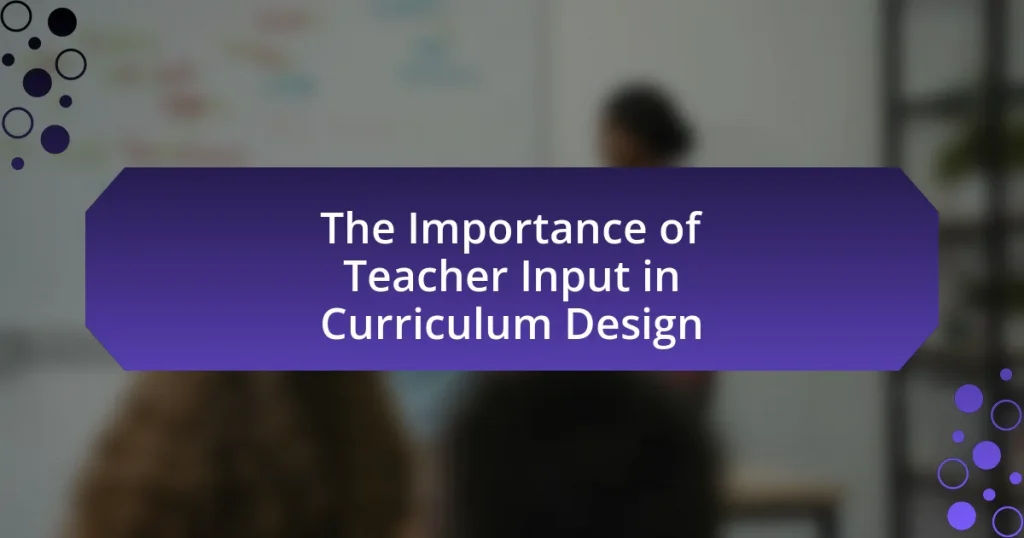Building a curriculum that promotes critical thinking skills involves creating educational programs that encourage students to analyze, evaluate, and generate new ideas rather than merely memorizing information. This article explores the significance of critical thinking in education, highlighting its impact on student learning outcomes and academic performance. Key components of critical thinking, effective teaching methods, and the role of assessments in fostering these skills are discussed. Additionally, the article addresses challenges educators may face in implementing such curricula and offers practical strategies and resources to enhance critical thinking in the classroom.

What is Building a Curriculum that Promotes Critical Thinking Skills?
Building a curriculum that promotes critical thinking skills involves designing educational programs that encourage students to analyze, evaluate, and create new ideas rather than simply memorizing information. This approach integrates activities that require problem-solving, reasoning, and reflection, fostering an environment where students can engage in discussions, debates, and collaborative projects. Research indicates that curricula emphasizing critical thinking lead to improved academic performance and better preparation for real-world challenges, as evidenced by studies showing that students exposed to such curricula demonstrate higher levels of engagement and deeper understanding of content.
Why is critical thinking important in education?
Critical thinking is important in education because it equips students with the ability to analyze information, evaluate arguments, and make reasoned decisions. This skill fosters independent thinking and enhances problem-solving capabilities, which are essential for academic success and real-world applications. Research indicates that students who engage in critical thinking perform better academically; for instance, a study published in the Journal of Educational Psychology found that critical thinking instruction significantly improved students’ performance on standardized tests. Thus, integrating critical thinking into the curriculum is vital for developing informed, capable individuals.
What are the key components of critical thinking?
The key components of critical thinking are analysis, evaluation, inference, explanation, and problem-solving. Analysis involves breaking down complex information into manageable parts to understand it better. Evaluation refers to assessing the credibility and relevance of information sources. Inference is the ability to draw logical conclusions from available evidence. Explanation entails clearly articulating reasoning and justifying conclusions. Problem-solving involves identifying solutions to complex issues by applying critical thinking skills. These components are essential for developing a curriculum that effectively promotes critical thinking skills in learners.
How does critical thinking influence student learning outcomes?
Critical thinking significantly enhances student learning outcomes by fostering deeper understanding and retention of knowledge. When students engage in critical thinking, they analyze, evaluate, and synthesize information, which leads to improved problem-solving skills and greater academic performance. Research indicates that students who practice critical thinking demonstrate higher levels of achievement, as evidenced by a study published in the Journal of Educational Psychology, which found that critical thinking instruction resulted in a 20% increase in test scores among participants. This correlation underscores the importance of integrating critical thinking into curricula to optimize educational effectiveness.
What are the characteristics of a curriculum that fosters critical thinking?
A curriculum that fosters critical thinking is characterized by its emphasis on inquiry-based learning, interdisciplinary approaches, and the integration of real-world problems. Inquiry-based learning encourages students to ask questions, explore, and engage in discussions, which enhances their analytical skills. Interdisciplinary approaches allow students to make connections across subjects, promoting a deeper understanding of complex issues. Additionally, incorporating real-world problems into the curriculum helps students apply critical thinking skills in practical contexts, preparing them for challenges outside the classroom. Research by Facione (2011) highlights that such curricula lead to improved problem-solving abilities and greater student engagement, validating the effectiveness of these characteristics in fostering critical thinking.
How can curriculum design incorporate critical thinking strategies?
Curriculum design can incorporate critical thinking strategies by integrating problem-based learning, which encourages students to engage with real-world issues and develop analytical skills. This approach allows learners to explore complex problems, evaluate evidence, and formulate solutions, fostering a deeper understanding of the subject matter. Research by Hmelo-Silver (2004) in “Problem-Based Learning: An Instructional Model and Its Constructivist Framework” demonstrates that problem-based learning enhances critical thinking abilities by promoting inquiry and collaboration among students.
What role do assessments play in promoting critical thinking?
Assessments play a crucial role in promoting critical thinking by providing structured opportunities for students to analyze, evaluate, and synthesize information. Through various assessment formats, such as open-ended questions, projects, and discussions, educators can gauge students’ understanding and encourage deeper cognitive engagement. Research indicates that formative assessments, which offer feedback during the learning process, significantly enhance critical thinking skills by prompting students to reflect on their reasoning and decision-making processes. For instance, a study published in the Journal of Educational Psychology found that students who participated in formative assessments demonstrated improved critical thinking abilities compared to those who did not. This evidence underscores the importance of assessments in fostering an environment where critical thinking can thrive.

How can educators effectively implement a curriculum that promotes critical thinking skills?
Educators can effectively implement a curriculum that promotes critical thinking skills by integrating inquiry-based learning, which encourages students to ask questions, explore, and engage in problem-solving activities. Research indicates that inquiry-based learning enhances critical thinking by allowing students to investigate real-world problems, fostering deeper understanding and analytical skills. For instance, a study published in the Journal of Educational Psychology found that students who participated in inquiry-based learning demonstrated significantly higher critical thinking abilities compared to those in traditional learning environments. By incorporating collaborative projects, discussions, and reflective practices, educators can create a dynamic learning atmosphere that nurtures critical thinking.
What teaching methods support critical thinking development?
Teaching methods that support critical thinking development include inquiry-based learning, problem-based learning, and Socratic questioning. Inquiry-based learning encourages students to ask questions and explore topics deeply, fostering analytical skills. Problem-based learning presents real-world challenges that require students to apply their knowledge and think critically to find solutions. Socratic questioning promotes dialogue and reflection, pushing students to articulate their reasoning and consider multiple perspectives. Research indicates that these methods enhance students’ ability to analyze information and develop reasoned arguments, as evidenced by studies showing improved critical thinking scores in classrooms that implement these strategies.
How can collaborative learning enhance critical thinking?
Collaborative learning enhances critical thinking by fostering an environment where individuals engage in dialogue, share diverse perspectives, and challenge each other’s ideas. This interaction encourages deeper analysis and evaluation of concepts, as students must articulate their reasoning and consider alternative viewpoints. Research by Johnson and Johnson (1994) indicates that cooperative learning strategies lead to higher-level thinking skills, as students are required to justify their thoughts and negotiate meaning with peers. This process not only strengthens critical thinking but also promotes a sense of accountability and ownership over learning outcomes.
What are the benefits of inquiry-based learning in fostering critical thinking?
Inquiry-based learning significantly enhances critical thinking by encouraging students to ask questions, investigate, and engage in problem-solving. This approach fosters a deeper understanding of content as students actively explore concepts rather than passively receive information. Research indicates that inquiry-based learning promotes higher-order thinking skills, as evidenced by a study published in the Journal of Educational Psychology, which found that students engaged in inquiry-based activities demonstrated improved analytical skills and creativity compared to those in traditional learning environments. By prioritizing exploration and questioning, inquiry-based learning cultivates an environment where critical thinking can thrive.
What challenges might educators face in implementing such a curriculum?
Educators may face several challenges in implementing a curriculum that promotes critical thinking skills. One significant challenge is the lack of adequate training for teachers, as many educators may not have received formal instruction on how to effectively teach critical thinking. Research indicates that only 30% of teachers feel prepared to teach critical thinking skills, which can hinder the successful integration of such a curriculum. Additionally, educators may encounter resistance from students who are accustomed to traditional rote learning methods, making it difficult to shift their mindset towards more analytical and evaluative thinking. Furthermore, limited resources, including time constraints and insufficient materials, can impede the development and execution of lessons that foster critical thinking. These challenges collectively impact the effectiveness of implementing a curriculum designed to enhance critical thinking skills among students.
How can resistance to change be addressed in educational settings?
Resistance to change in educational settings can be addressed by fostering a culture of collaboration and open communication among educators, administrators, and stakeholders. Engaging all parties in the decision-making process helps to build trust and reduces anxiety associated with change. Research indicates that when educators are involved in the planning and implementation of new curricula, such as those promoting critical thinking skills, they are more likely to embrace the changes. For instance, a study by Fullan (2007) emphasizes the importance of shared leadership and collective responsibility in facilitating successful educational reforms. By providing professional development opportunities and ongoing support, educational institutions can further alleviate resistance and encourage a positive attitude towards change.
What resources are available to support educators in this process?
Educators can access various resources to support the process of building a curriculum that promotes critical thinking skills. These resources include professional development programs, online courses, and instructional materials specifically designed to enhance critical thinking. For instance, organizations like the Critical Thinking Consortium provide workshops and resources that focus on integrating critical thinking into the curriculum. Additionally, platforms such as Edutopia offer articles and videos that showcase effective teaching strategies for fostering critical thinking. Research indicates that structured professional development can significantly improve educators’ ability to teach critical thinking, as evidenced by studies published in the Journal of Educational Psychology, which highlight the positive impact of targeted training on teaching practices.

What are the best practices for evaluating the effectiveness of a critical thinking curriculum?
The best practices for evaluating the effectiveness of a critical thinking curriculum include the use of standardized assessments, formative evaluations, and qualitative feedback mechanisms. Standardized assessments, such as the California Critical Thinking Skills Test, provide measurable data on students’ critical thinking abilities before and after curriculum implementation. Formative evaluations, including regular quizzes and reflective journals, allow educators to monitor student progress and adapt teaching strategies accordingly. Qualitative feedback, gathered through student interviews and focus groups, offers insights into students’ perceptions of their critical thinking development. These methods collectively ensure a comprehensive evaluation of the curriculum’s impact on critical thinking skills.
How can educators measure critical thinking skills in students?
Educators can measure critical thinking skills in students through assessments that evaluate reasoning, analysis, and problem-solving abilities. Tools such as standardized tests, performance-based assessments, and rubrics specifically designed to assess critical thinking can provide quantifiable data on students’ skills. For instance, the California Critical Thinking Skills Test (CCTST) is a widely recognized tool that assesses critical thinking across various domains, providing educators with reliable metrics to gauge student performance. Additionally, incorporating reflective writing assignments and group discussions can help educators observe students’ thought processes and reasoning in real-time, further validating their critical thinking capabilities.
What types of assessments are most effective for evaluating critical thinking?
Performance-based assessments are the most effective for evaluating critical thinking. These assessments require students to apply their knowledge and skills to real-world problems, demonstrating their ability to analyze, evaluate, and create solutions. Research indicates that performance-based assessments, such as project-based learning, case studies, and simulations, engage students in higher-order thinking and provide a more accurate measure of their critical thinking abilities compared to traditional tests. For instance, a study by the American Educational Research Association found that students who participated in project-based assessments scored significantly higher on critical thinking measures than those who took standard multiple-choice tests.
How can feedback be used to improve critical thinking skills?
Feedback can be used to improve critical thinking skills by providing specific, actionable insights that guide learners in evaluating their thought processes. When feedback highlights areas of strength and weakness, it encourages individuals to reflect on their reasoning and decision-making strategies. Research indicates that formative feedback, which is ongoing and constructive, significantly enhances critical thinking abilities by prompting learners to analyze their assumptions and consider alternative viewpoints. For instance, a study published in the Journal of Educational Psychology found that students who received detailed feedback on their arguments demonstrated a 25% improvement in critical thinking assessments compared to those who did not receive such feedback. This evidence supports the notion that effective feedback fosters a deeper understanding of critical thinking concepts and promotes skill development.
What practical tips can educators use to enhance critical thinking in their classrooms?
Educators can enhance critical thinking in their classrooms by incorporating inquiry-based learning, which encourages students to ask questions and explore topics deeply. This method fosters an environment where students engage in problem-solving and analytical thinking. Research shows that inquiry-based learning can improve students’ critical thinking skills significantly, as evidenced by a study published in the Journal of Educational Psychology, which found that students engaged in inquiry-based activities scored higher on assessments measuring critical thinking compared to those in traditional learning settings. Additionally, educators can implement collaborative group work, where students discuss and debate ideas, further promoting critical analysis and reasoning.



